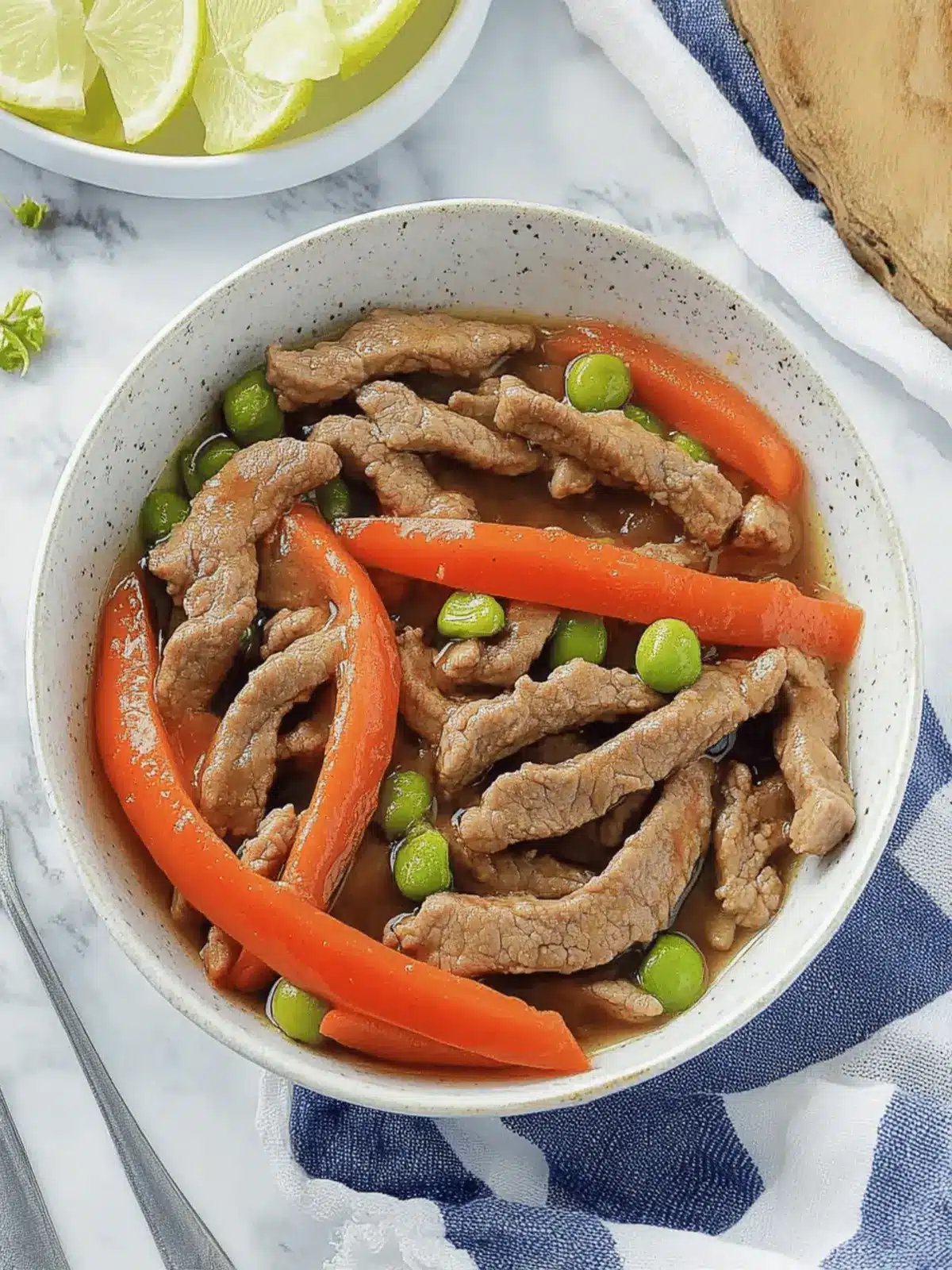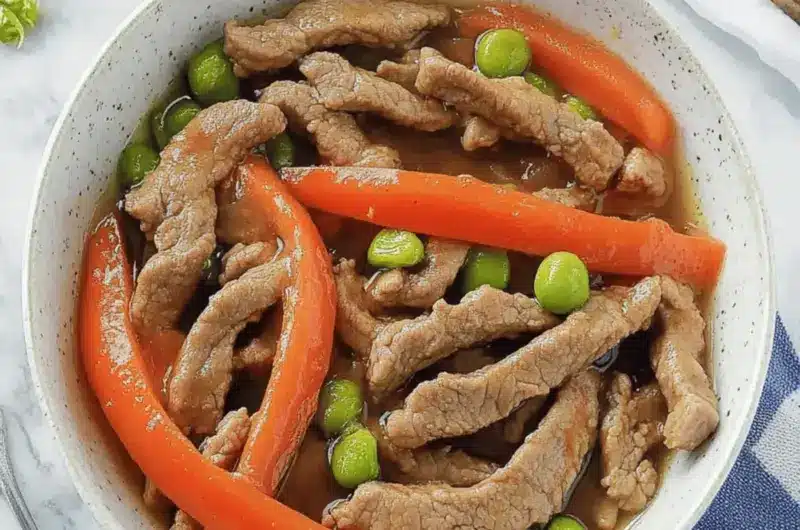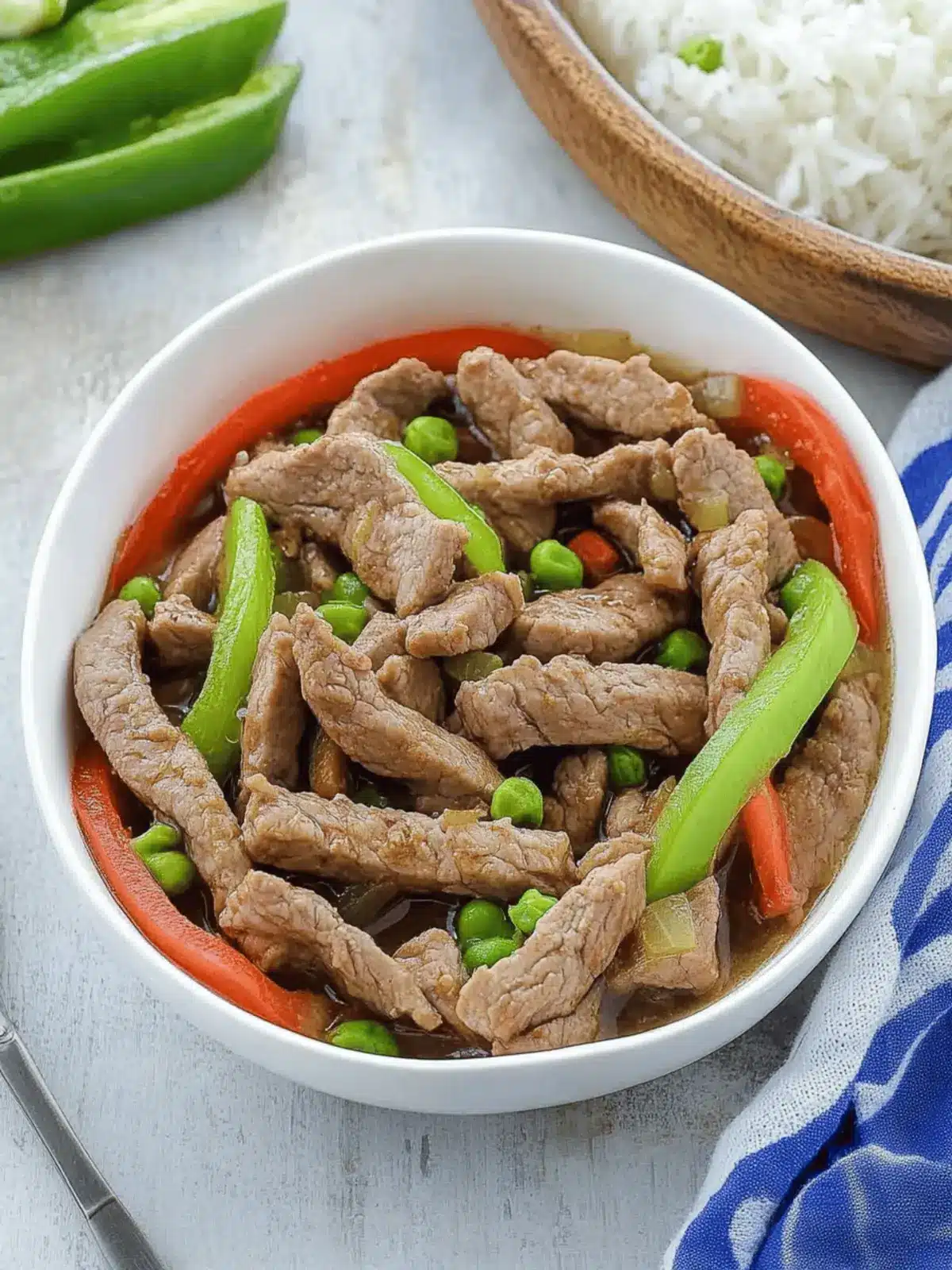The first time I tried Igado, I was taken aback by the depth of flavor that enveloped each tender bite of pork and beef liver. As the enticing aroma of garlic and vinegar wafted through the kitchen, I knew I had stumbled upon something special. This dish, steeped in tradition, marries simple ingredients with rich, hearty flavors that can elevate any mealtime.
Imagine gathering your loved ones around the table, the vibrant colors of bell peppers and peas creating a feast for the eyes, while the warm, savory scent invites everyone to dig in. Perfect for those who are tired of fast food and craving a wholesome homemade meal, Igado not only satisfies hunger but also serves as a delightful conversation starter.
Whether you’re looking to impress guests or simply enjoy a comforting dinner after a long day, this recipe shines with its ease and versatility. Join me in bringing this beloved dish into your home, where it’s sure to become a new favorite!
Why is Igado a must-try dish?
Flavorful Fusion: Each bite of Igado is a celebration of taste, blending savory pork and rich beef liver with tangy vinegar and aromatic spices.
Heartwarming Experience: The vibrant mix of colors from the bell peppers and peas transforms your plate into a feast that warms both the heart and the soul.
Quick Prep: With just 15 minutes of prep time, you can have a comforting meal on the table in just over an hour.
Crowd-Pleasing: Perfect for gatherings, this dish will impress your family and friends, leaving them raving about your culinary skills!
Versatile Dish: Serve it over rice for a hearty dinner or pair it with crusty bread for a cozy lunch. Whichever way you choose, you can easily elevate your meal with this delightful recipe!
For more tantalizing ideas, check out my collection of easy Filipino recipes.
Igado Ingredients
For the Pork Marinade
• Pork tenderloin – the star ingredient that brings tenderness and richness to Igado.
• Vinegar – adds a tangy kick, essential for authentic Filipino flavor.
• Soy sauce – enhances the dish with a savory depth and umami punch.
• Onion – sweetens the dish while providing aromatic support when sautéed.
• Bay leaves – impart a subtle herbal layer that complements the meat.
• Peppercorns – introduces a hint of spice, making each bite exciting.
• Garlic – infuses the marinade with a fragrant warmth.
For Cooking
• Canola oil – a neutral oil for sautéing that allows the flavors to shine through.
• Red bell pepper – adds vibrant color and a sweet crunch to the dish.
• Water – balances the flavors while creating a luscious sauce.
For the Liver Mixture
• Beef liver – lends a rich, creamy texture that pairs perfectly with the pork.
• Frozen green peas – add a pop of color and a slightly sweet burst in each bite.
• Salt – remember to season to taste for enhanced flavors!
This delightful Igado recipe brings together simple yet flavorful ingredients that are sure to create a memorable meal full of warmth and love.
How to Make Igado
-
Marinate the pork: In a bowl, combine the pork strips with vinegar, soy sauce, sliced onions, minced garlic, bay leaves, and cracked peppercorns. Allow it to marinate for about 15 to 20 minutes for maximum flavor.
-
Drain the meat: After marinating, gently drain the pork, squeezing out excess liquid, while reserving the marinade and aromatics to infuse during cooking.
-
Sauté bell peppers: In a pan over medium-high heat, add canola oil. Toss in the sliced bell peppers and cook for about 30 seconds. Remove them from the pan and set aside.
-
Cook the pork: Add the marinated pork to the same pan and cook, stirring occasionally, until the meat’s color changes, indicating it’s starting to brown.
-
Combine aromatics: Add back the marinated onions, garlic, bay leaves, and peppercorns to the pan, cooking until softened and the pork is lightly browned for about 4 to 5 minutes.
-
Boil the marinade: Pour in the reserved marinade and bring to a boil without stirring, letting it bubble uncovered for about 4 to 5 minutes to deepen the flavors.
-
Add water: Pour in the water and bring the mixture to a boil once again, preparing it for simmering.
-
Simmer and cover: Lower the heat, cover the pan, and simmer for about 25 to 30 minutes, or until the pork is tender and the liquid has reduced to a rich sauce.
-
Incorporate liver: Add the beef liver, gently stirring to combine, and continue to cook for another 4 to 5 minutes, ensuring the liver is cooked through and the sauce thickens.
-
Mix in green peas: Stir in the thawed green peas and cook for about 2 to 3 minutes until they’re heated through, adding freshness to the dish.
-
Finish with bell peppers: Add the sautéed bell peppers back to the pan and continue to cook for an additional 1 to 2 minutes until they are tender yet remain crisp.
-
Season to taste: Finally, sprinkle in salt according to your preference, giving the dish a final stir before serving hot.
Optional: Garnish with fresh herbs for a vibrant touch!
Exact quantities are listed in the recipe card below.
Make Ahead Options
These delectable Igado are ideal for busy weeknights or meal prep enthusiasts! You can marinate the pork tenderloin up to 24 hours in advance, allowing the flavors to deepen. Simply combine the pork with vinegar, soy sauce, onions, garlic, bay leaves, and peppercorns, then refrigerate the marinade in an airtight container. The sautéed bell peppers can be prepared and stored separately for up to 3 days in the fridge. When you’re ready to serve, just cook the marinated pork, add the reserved seasoning and bell peppers, and finish with the liver and peas for a comforting meal that tastes just as delicious as if it were made fresh. This streamlined approach provides you with flavorful results with minimal effort!
How to Store and Freeze Igado
Fridge: Store leftover Igado in an airtight container for up to 3 days. Ensure it’s completely cooled down before sealing to maintain freshness.
Freezer: For longer storage, freeze Igado in an airtight container for up to 3 months. When ready to enjoy, thaw overnight in the fridge before reheating.
Reheating: To reheat, warm it on the stovetop over low heat, stirring occasionally, until heated through. You can add a splash of water if needed for a saucier consistency.
Refreezing: Avoid refreezing Igado after it’s been thawed, as this can affect the texture and flavor of this delicious dish.
Igado Variations
Feel free to explore these delightful twists and turns to personalize your igado experience!
-
Pork Alternatives: Swap pork tenderloin for chicken breast for a leaner, yet still satisfying version. It will offer a different flavor profile while maintaining that heartwarming essence.
-
Liver-free: Replace beef liver with mushrooms for a vegetarian alternative! The earthy flavors of mushrooms add depth to the dish without needing meat.
-
Vegan: Use tofu marinated in soy sauce and vinegar as a meat substitute, combined with an assortment of vegetables, for a plant-based delight that doesn’t skimp on flavor.
-
Extra Spice: Add chopped fresh chili or a dash of chili flakes to give your igado an energizing kick. Perfect for those who enjoy their meals with a bit of heat!
-
Herbed Twist: Incorporate fresh herbs like cilantro or basil at the end of cooking for a refreshing layer of flavor, bringing a new dimension to this classic dish.
-
Sweet Twist: A tablespoon of honey or brown sugar will balance the tartness of the vinegar, creating a lovely harmony and a slightly sweet contrast to the savory notes.
-
Nuts for Crunch: Toss in some toasted cashews or peanuts just before serving for a delightful crunch that adds texture and an unexpected twist.
-
Coconut Version: Substitute half of the water with coconut milk to create a creamy and tropical flair in your igado that’s simply irresistible!
Expert Tips for Igado
-
Marinate Longer: For even richer flavors, consider marinating the pork for up to an hour. This enhances the overall taste of your Igado.
-
Avoid Overcooking Liver: Beef liver cooks quickly; don’t leave it on the heat for too long to prevent a rubbery texture. Aim for 4 to 5 minutes once added to the dish.
-
Adjust Acidity: If the dish tastes too tangy, mellow it with a teaspoon of sugar or a splash of water, achieving a balanced flavor profile in your Igado.
-
Ingredient Quality: Opt for fresh ingredients, especially bell peppers and peas, for a vibrant color and taste that brings your dish to life.
-
Test for Tenderness: Ensure the pork is fork-tender during simmering; if not, allow it to cook longer. This step is crucial for perfect igado consistency.
-
Serve with Rice: Pair Igado with steamed rice to soak up the savory sauce, transforming your meal into a warm comfort experience!
What to Serve with Igado?
A well-crafted meal is all about balance, and pairing the rich flavors of Igado with complementary sides makes it truly unforgettable.
-
Steamed Rice: The classic pairing that soaks up the rich sauce, providing a comforting base that enhances every flavorful bite of Igado.
-
Garlic Fried Rice: Infused with garlic, this fragrant option elevates your meal, marrying well with the tangy notes of the dish and adding an extra layer of deliciousness.
-
Pickled Vegetables: A crisp and tangy side that cuts through the richness of Igado, brightening up your plate and refreshing the palate between bites.
-
Sautéed Bok Choy: Lightly sautéed greens bring a pleasant crunch while adding a vibrant green contrast to the hearty igado, making it a nutritious companion.
-
Sinigang Soup: Its sour and savory profile acts as a perfect balancing act against the richness of Igado. Plus, it adds a comforting warmth that resonates across Filipino meals.
-
Fresh Green Salad: Lightly dressed with a tangy vinaigrette, a fresh salad introduces a burst of crisp flavors and textures, harmonizing beautifully with the savory notes of the Igado.
-
Chilled Lemonade: Refreshing and zesty, this drink complements the dish by cleansing the palate after every savory mouthful, making your dining experience satisfying.
-
Mango Float: For dessert, this sweet and creamy treat is the perfect finish, offering a light and sweet contrast to the savory richness of Igado, making it a delightful conclusion to the meal.
Igado Recipe FAQs
What kind of vinegar should I use for Igado?
Absolutely! For Igado, it’s best to use a cane vinegar known as “sukang cane” for that authentic Filipino flavor. However, you can also use white vinegar or apple cider vinegar if that’s what you have on hand. Just remember that the vinegar is a key element in balancing the dish’s richness!
How should I store leftover Igado?
Leftover Igado can be stored in an airtight container in the refrigerator for up to 3 days. Make sure to let it cool completely before sealing it to keep it fresh. To enjoy it later, simply reheat it on the stovetop over low heat.
Can I freeze Igado?
Yes, you can freeze Igado! Just place it in an airtight container or a heavy-duty freezer bag, and it will stay good for up to 3 months. When you’re ready to enjoy it, thaw it overnight in the fridge, and gently reheat on the stove, adding a splash of water if needed for moisture.
What can I do if the liver is tough in my Igado?
If you find that the liver in your Igado is tough, it’s likely because it was overcooked. To prevent this, cook the beef liver for only about 4 to 5 minutes once added to the dish. Always ensure that the liver is thoroughly cooked but not exceeding that time to avoid a rubbery texture. It’s all about timing!
Is Igado suitable for people with dietary restrictions?
Very! While Igado includes pork and beef liver, it can be adapted to accommodate certain dietary restrictions. For those avoiding red meat, you can replace the beef liver with chicken liver or skip it altogether, relying solely on the marinated pork for a delicious outcome. Just be cautious about any ingredient allergies, particularly with soy sauce, which can be high in sodium.
How do I ensure the pork in Igado is tender?
To achieve fork-tender pork in your Igado, simmer it covered for 25 to 30 minutes after adding water. During this time, check on it occasionally and give it a stir. If the pork isn’t tender yet, continue simmering until it reaches that perfect softness you want. Trust me, the tender meat absorbs the sauce beautifully, enhancing the overall flavor!

Savor Igado: A Soul-Warming Filipino Pork Delight
Ingredients
Equipment
Method
- Marinate the pork: In a bowl, combine the pork strips with vinegar, soy sauce, sliced onions, minced garlic, bay leaves, and cracked peppercorns. Allow it to marinate for about 15 to 20 minutes for maximum flavor.
- Drain the meat: After marinating, gently drain the pork, squeezing out excess liquid, while reserving the marinade and aromatics to infuse during cooking.
- Sauté bell peppers: In a pan over medium-high heat, add canola oil. Toss in the sliced bell peppers and cook for about 30 seconds. Remove them from the pan and set aside.
- Cook the pork: Add the marinated pork to the same pan and cook, stirring occasionally, until the meat’s color changes, indicating it's starting to brown.
- Combine aromatics: Add back the marinated onions, garlic, bay leaves, and peppercorns to the pan, cooking until softened and the pork is lightly browned for about 4 to 5 minutes.
- Boil the marinade: Pour in the reserved marinade and bring to a boil without stirring, letting it bubble uncovered for about 4 to 5 minutes to deepen the flavors.
- Add water: Pour in the water and bring the mixture to a boil once again, preparing it for simmering.
- Simmer and cover: Lower the heat, cover the pan, and simmer for about 25 to 30 minutes, or until the pork is tender and the liquid has reduced to a rich sauce.
- Incorporate liver: Add the beef liver, gently stirring to combine, and continue to cook for another 4 to 5 minutes, ensuring the liver is cooked through and the sauce thickens.
- Mix in green peas: Stir in the thawed green peas and cook for about 2 to 3 minutes until they’re heated through, adding freshness to the dish.
- Finish with bell peppers: Add the sautéed bell peppers back to the pan and continue to cook for an additional 1 to 2 minutes until they are tender yet remain crisp.
- Season to taste: Finally, sprinkle in salt according to your preference, giving the dish a final stir before serving hot.











